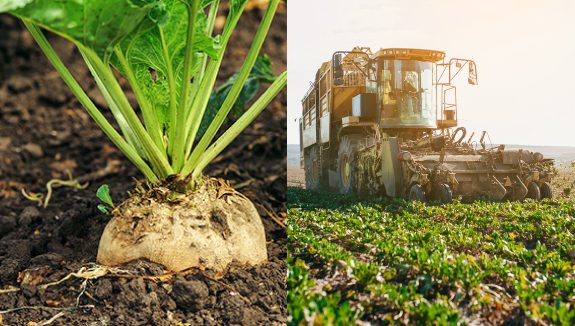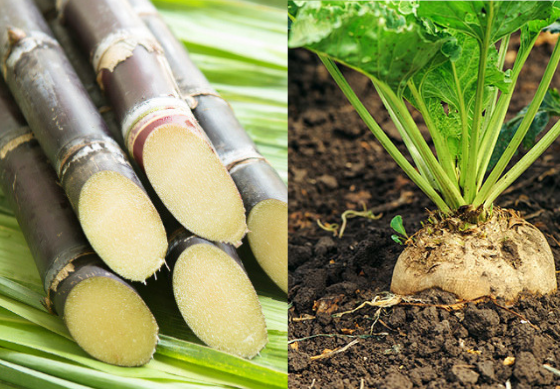The Importance of Sugar Beet Vs Sugar Cane: a Closer Check Out Their Manufacturing Processes and Applications
The value of sugar beet and sugar cane extends beyond their function as resources of sucrose. Each crop features distinct producing procedures that affect their applications across different markets. While sugar beet supports not simply food manufacturing yet likewise biofuels and plant foods, sugar cane primarily serves the food market with beneficial byproducts. Comprehending these differences reveals exactly how each plant forms farming economic climates and sector techniques worldwide, prompting additional expedition into their one-of-a-kind contributions.

Summary of Sugar Beet and Sugar Cane
Sugar beet and sugar cane are two primary resources of sucrose, each with unique characteristics and farming approaches. Sugar beet, a root veggie, prospers in pleasant climates - Sugar beet vs sugar cane. It is cultivated largely in the North Hemisphere and needs well-drained dirt. The plant typically expands to an elevation of concerning 18 inches, with a white, fleshy root having regarding 15-20% sucrose. On the other hand, sugar cane is an exotic yard that grows in warm, damp problems. It can get to elevations of approximately 12 feet and includes tall, jointed stems that store sucrose focus varying from 10-15%. The farming of sugar cane is labor-intensive and usually involves hands-on harvesting. Both crops work as crucial farming products, offering resources for sugar manufacturing and various by-products. Their cultivation methods substantially influence neighborhood economic climates and worldwide sugar markets, making them essential to the farming landscape
Collecting Strategies for Sugar Beet and Sugar Cane
Harvesting techniques for sugar beet and sugar cane differ noticeably as a result of the special qualities of each plant. Sugar beet harvesting normally utilizes specific equipment called beet farmers, which successfully uproot the beets from the soil while minimizing damage. These equipments use a collection of blades to reduce the tops and lift the origins, making certain that the beets continue to be intact for processing.In comparison, sugar cane harvesting typically entails 2 key techniques: hand-operated cutting and mechanical harvesting. Manual harvesting, still prevalent in some areas, requires employees to reduce the cane stalks by hand making use of machetes. This approach permits careful harvesting but is labor-intensive. Mechanical farmers have acquired appeal, utilizing revolving blades to reduce and collect the stalks swiftly. Both approaches intend to optimize return and quality, with mechanical harvesting significantly embraced to fulfill rising manufacturing demands effectively.
Processing Approaches for Sugar Beet
After being collected, sugar beetroots go through a series of handling actions to draw out sucrose successfully. The initial step includes washing the beetroots to remove soil and pollutants. Next, the beets are sliced into thin strips recognized as cossettes, which enhances the surface for extraction. These cossettes are after that based on warm water extraction in a diffusion procedure, enabling sucrose to liquify into the water.Following removal, the juice includes contaminations and is made clear using lime and heat to precipitate solids. The made clear juice is after that concentrated through dissipation, eliminating excess water and enhancing sugar concentration. To crystallize the sucrose, the focused juice goes through more dissipation and air conditioning, forming sugar crystals. Finally, these crystals are separated from the staying syrup via centrifugation, dried, and packaged for distribution. This technique guarantees a high yield of sucrose while maintaining the quality of the last item.
Processing Approaches for Sugar Cane
Processing sugar cane includes a collection of actions designed to draw out sucrose efficiently. The process starts with harvesting, where mature sugar cane is reduced and delivered to refining facilities. When at the mill, the cane undergoes cleaning to remove contaminations. The next action is crushing, where mechanical rollers extract juice from the coarse stalks.This juice is then made clear using heat and lime to remove suspended solids and impurities. Complying with clarification, the juice is vaporized to concentrate the sugar content, resulting in a thick syrup. The syrup goes through condensation, where sugar crystals create as the syrup cools. These crystals are separated from the staying molasses with centrifugation.Finally, the sugar is dried and packaged for circulation. This thorough processing approach guarantees that sugar cane produces a top notch item, ideal for numerous cooking and industrial applications, while taking full advantage of the extraction of sucrose from the raw material.
Nutritional Differences In Between Sugar Beet and Sugar Cane
The comparison in between sugar beet and sugar cane expands beyond their handling methods to incorporate significant dietary differences. Sugar beet has not only sucrose but likewise a variety of minerals and vitamins, including vitamin C, potassium, and magnesium. These nutrients contribute to its read what he said prospective health advantages, such as supporting immune function and preserving electrolyte equilibrium. In contrast, sugar cane mainly provides sucrose with very little degrees of necessary nutrients.Additionally, sugar beet has a higher fiber web content, which can assist in digestion and advertise satiety. The presence of anti-oxidants in sugar beet might also supply protective impacts against oxidative tension, an element connected to different chronic conditions. While both resources are mostly utilized for sugar production, the nutritional accounts suggest that sugar beet might supply extra wellness advantages compared to sugar cane. This difference is important for consumers looking for more than just sugar in their diets.
Applications of Sugar Beet in Numerous Industries
A range of industries take advantage of sugar beet for its flexible applications past sugar manufacturing. In the food sector, sugar beet works as a key component in creating different refined foods, including sweets and baked goods, as a result of its all-natural sweetness. Additionally, the pulp acquired from sugar beet is used as animal feed, providing a nutrient-rich resource for livestock.In the biofuel field, sugar beet is increasingly recognized for its potential in creating bioethanol, adding to renewable resource remedies. The agricultural field take advantage of sugar beet's by-products, which can be used as natural fertilizers, enriching dirt health and wellness and fertility.Furthermore, sugar beet removes are utilized Get More Info in pharmaceuticals and cosmetics, where they operate as natural sugar and humectants. These diverse applications highlight sugar beet's role as an important resource in boosting sustainability and advancement across numerous industries, enhancing its importance in modern manufacturing practices.
Applications of Sugar Cane in Numerous Industries

Frequently Asked Questions
What Environmental Effects Are Linked With Sugar Beet and Sugar Cane Manufacturing?
The ecological impacts of sugar beet and sugar cane production include soil deterioration, water use, chemical application, and environment disturbance. These elements add to environmental discrepancies, increasing problems regarding sustainability in agricultural techniques related to both crops.

How Do Sugar Beet and Sugar Cane Compare in Regards To Economic Practicality?
The financial stability of sugar beet and sugar cane varies view it based upon variables like geographic area, manufacturing costs, and market demand - Sugar beet vs sugar cane. Both plants supply unique advantages, influencing farmers' choices relating to farming and financial investment in different areas
What Are the Key Regions for Sugar Beet and Sugar Cane Farming?

Exactly How Does Environment Affect the Growth of Sugar Beet and Sugar Cane?
Environment significantly affects the growth of sugar beet and sugar cane. Sugar beetroots grow in cooler temperatures, while sugar cane needs cozy, exotic conditions. Sugar beet vs sugar cane. Both crops depend upon ample rains and sunlight for perfect development and return
Exist Any Type Of Substantial Wellness Problems Connected to Consuming Sugar From These Resources?
Wellness problems relevant to sugar consumption include obesity, diabetic issues, and heart problem. Both sugar beet and sugar cane-derived sugars can add to these issues, especially when consumed in excessive amounts, no matter of their resource.